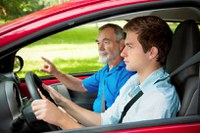Top Tips from Driving Schools
 “Pre-flight” check:
“Pre-flight” check:
- Adjust mirrors and seats before turning on the vehicle.
- Turn on your headlights, day and night, for safety.
- Limit distractions by turning phone off and radio down.
- When backing up, do not rely on the rear view mirror. Always turn and look directly behind you. Check all directions before proceeding.
Stopping and safe distances:
- Stop completely at stop signs and red lights. Brake smoothly—avoid slamming on the brakes.
- Stop far enough back that you can see the tires of the vehicle in front of you.
- When proceeding, look left, right, straight ahead, then left again before moving.
- Remain 15 feet away from trucks on all sides. If you can't see truck drivers in their mirrors, they can't see you either.
How fast is too fast?
- Don't exceed the speed limit. The chance of death or serious injury doubles for every 10 miles per hour over 50 mph that a vehicle travels.
- At high speeds, turning too quickly or braking too sharply can result in an out-of-control vehicle.
- Speed increases braking distance: If you double your speed, quadruple your braking distance.
- At high speeds, the amount of time available to detect and react to unexpected events is shortened.
Driving distractions:
Driving while distracted is hazardous for everyone, especially inexperienced drivers. Trying to dip your fries in ketchup while navigating traffic is not such a good idea. Other common distractions:
- Chatting with other passengers
- Drinking and eating
- Selecting music from CD or iPod
- Applying makeup
- Reading directions or a map
-
Using a cell phone (texting and talking are illegal in CO if you’re under 18)
Night Driving
Driving at night increases the likelihood and severity of crashes. The risk of being in a fatal crash is highest for teens between 9 p.m. and 6 a.m.
Before driving unsupervised at night, you should have several months of daytime driving experience and extensive supervised practice driving at night. What’s the difference? At night:
- It's harder to see.
- Distance and speed are harder to judge.
- More impaired and unsafe drivers are on the road.
Remember—Colorado has a midnight and 5:00 a.m. curfew for teens.
"Ice and Snow, Take It Slow"
Words of advice for driving during a Colorado winter (or any season for that matter!): Slow down.
Rain, snow and ice make it more difficult to start, stop and turn. Even small amounts of precipitation make roads slippery. Plus, rain, fog, snow and sun glare make it more difficult to see. So if it's wet, snowy or icy—chill. Some quick tips:
- Maintain traction – start and stop gradually and drive at steady speeds.
- Skids – if your vehicle begins to skid, remove your foot from the accelerator or brake and steer in the direction of the skid.
- Braking – gently brake during slippery road conditions. Avoid braking on curves by driving through them at a safe, steady speed. Gear down when going uphill or downhill.
For more winter driving tips, read our Winter Driving Tips. (PDF)
